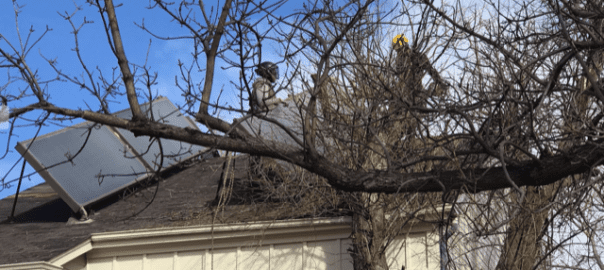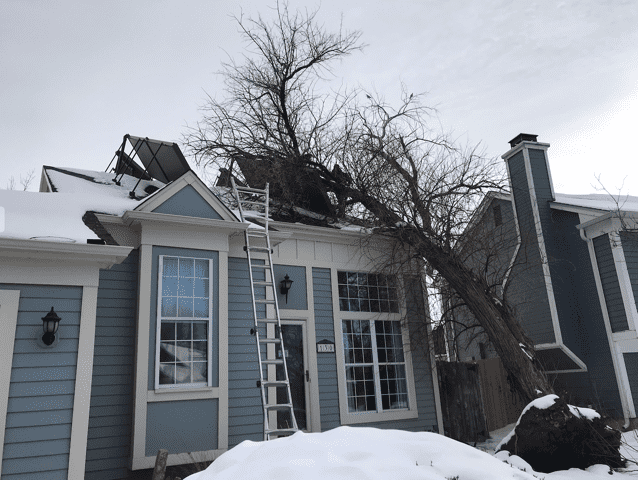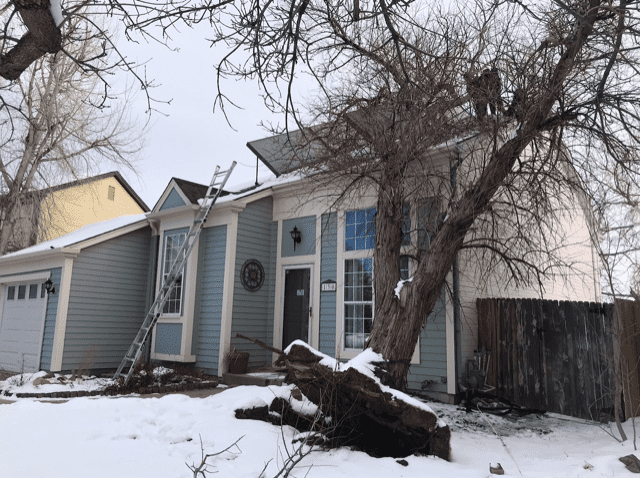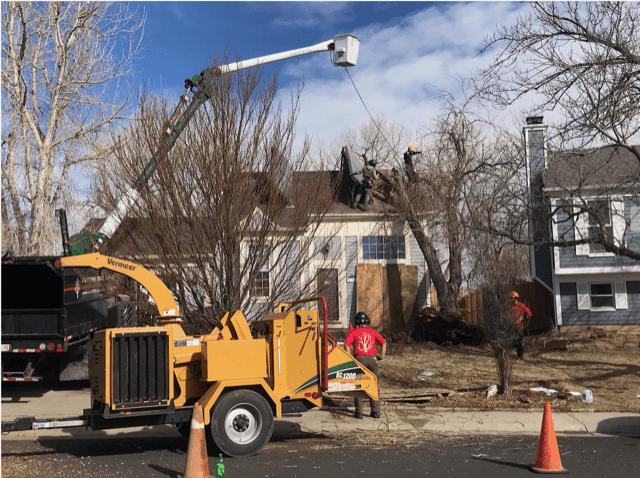During strong wind and snow storms, trees or tree limbs falling can cause serious roof damage, and tree removal is essential in these cases.
If a tree falls on your roof, the first thing to do is assess the situation.
Try to identify if there are any broken branches or tree limbs that could be causing additional damage as they remain in contact with the roof surface or nearby structures. When a tree falls against a roof, the force of the impact can easily cause limbs and branches to puncture a roof. It’s important not to attempt tree removal yourself and contact a professional tree service that can safely remove the tree or tree limbs, preventing further roof damage. It could be there the tree limb that has punctured your roof is holding it up from falling. Be careful if you are doing your own roof inspection.
Contact a reputable roofing company like Denny’s Roofing immediately to get them to come out and do a temporary emergency repair so that there is no additional storm damage with water or snow penetration. Your roofer should have a good tree service professional that they have worked with before that comes out and removes the tree or large branches.
You should also check in with your insurance company right away. Your homeowner’s policy will have coverage of some or all of the costs associated with tree removal, as well as any roof repairs that may be needed. Your roofer should be able to give you a rough idea of whether or not it makes sense to call in an Insurance Claim based on your deductible.
Again, call your local roofer, and they will have you navigate you through the Insurance process as you get the tree removed and your roof, fascia, soffits, and possibly gutters repaired.
How can you tell if a fallen tree has damaged your roof to the degree that requires professional roof repair?
If a tree falls on your roof, it’s essential to assess the damage immediately and determine if professional roof repair services are needed.
Homeowners should be on the lookout for these signs of tree-related roof damage:
- Broken or missing shingles: If you notice that some of your shingles have been broken or gone missing, it could indicate that tree debris has caused damage to your roof.
- Dents and punctures: Check for dents in the roof or holes from tree branches, sticks, or other debris that may have penetrated through the roofing materials.
- Debris buildup: Look for tree debris that may have accumulated on top of or around the roof. This debris can be tree branches, leaves, nuts, or other tree-related objects that have been left behind.
- Visible tree damage: If you can see tree damage on the tree itself, such as broken branches, misshapen trunks, or exposed roots, this could be a sign that tree debris has impacted your roof.
- Sagging or drooping roof sections: If you notice any sagging or drooping sections of your roof, this could indicate that tree debris has caused structural damage to the underlying support beams and needs to be addressed immediately by professionals.
- Interior Water Damage: Look at the ceiling above where the impact happened and see if there are water stains. You can also get your head up into the attic to see if you can see any daylight leaking through. You also might see a tree limb or branch literally sticking through the roof and an area of the eave that has been penetrated or crushed. That is an immediate sign of a hole in the roof and will need a temporary emergency repair.
By assessing these signs, homeowners can determine whether tree-related roof damage requires professional roof repair services. If you are unsure or have any questions, it is always best to consult a licensed roofing contractor to ensure the issue is properly and safely addressed. Contact us today for a free roof inspection!
Help protect your roof from tree damage in the future:
Keep tree branches trimmed and away from the roof line with regular tree pruning.
Tree pruning involves trimming away any tree branches that have grown too close to the roof line. This will help prevent tree branches from falling and damaging your roof, as well as helping to maintain the tree’s health and overall shape.
Pruning also helps keep tree branches away from power or telephone lines, which is vital for safety. It can also increase airflow around the tree and allow better sunlight access to all sides of the tree.
Tree pruning should ideally be done at least once every two years, and more often if you have a tree that grows quickly or is particularly large. When tree pruning, make sure to remove dead branches first, then reduce the size of side shoots and thin out any dense growth.
Make sure any trees near the home are healthy, with no signs of disease or decay.
This is important to do regularly so tree branches don’t suddenly break off and damage the roof or other property. Inspecting trees for signs of decay can help avoid costly tree falls on roofs and further property damage.
Check for any dead-looking branches or leaves that appear to be wilting or discolored compared to the rest of the tree. Also, look for any tree branches that are angled in an unusual way which could be caused by decay or disease. Another sign of tree decay is tree trunk wounds. If tree bark is cracked or there are visible tree wounds where the tree is exposed, it needs to be examined and possibly treated by a tree specialist. These tree trunk wounds can eventually cause tree branches to break off and create hazardous situations. Finally, check for any signs of rot on tree roots, as these can weaken the tree and cause tree falls or tree damage. A tree specialist may be required to identify tree root rot and suggest options for tree treatment.
Regularly inspecting trees near the home can avoid dangerous tree falls that could cause roof damage. Tree decay is a slow process, so paying attention to any unusual signs that the tree may be deteriorating is important. Taking action at the first sign of tree disease or tree decay is essential to protect property and maintain tree health near the home.
By taking these steps, homeowners can help protect their roofs from tree fall damage and save themselves time and money in the long run.
Remember, if a tree falls on your roof, make sure to contact your roofer and your insurance company immediately to ensure the tree is removed safely, and any damages are covered. Your roofer will help identify a good tree removal company.
Not sure if you have roof damage from trees or tree limbs?
Contact Denny’s Roofing today for a free roof inspection!




